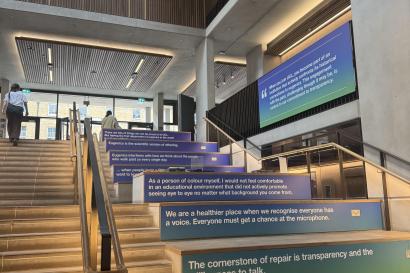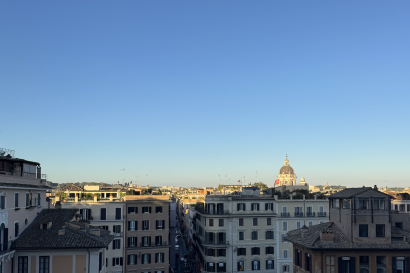As someone who’s considering joining the Peace Corp after college graduation, I was extremely interested in opportunities to volunteer during my semester abroad. When IES Abroadgave us the chance to spend a weekend building houses with Un Techo por mi País (A Roof for my Country), I couldn’t wait. Similar to Habitat for Humanity in the United States, Techo is an international NGO that organizes volunteers to build houses in impoverished neighborhoods. It seemed like a great way to meet locals and learn more about the community surrounding Buenos Aires, and it was free. I was sold. After finishing my weekend with Techo in late August, I’m so grateful for my experience.
The first thing that caught my attention about Techo when I got to the check-in location on Friday night was the size and scope of the event. The goal was to build around forty houses in three different barrios in the two days that we would be working. Almost three hundred Argentines, most of them in their late teens or early twenties, turned out to help. There were eight students from IES Abroad participating, but there must have been a misunderstanding, or some sort of cosmic joke, because when Techo assigned us to our respective barrios, five students were sent to one, two to another, and one student was placed in the third group by herself.
Of course, it was me that was alone. By myself. For an entire weekend. I’m not proud to say that I freaked out at the news. Even though I came to a Spanish-speaking country to jump in and practice my Spanish, the idea of spending a weekend by myself with so many locals intimidated me. I was worried that as soon as they realized my Spanish was slow and my grammar spotty, they would give up on talking to me or try to avoid me. I was worried I would have trouble making friends, or that I would feel homesick or lonely.
But almost immediately after boarding the bus to take me my barrio, a miracle happened. I made friends with the girl who sat next to me. She was nice, and patient, and understood me when I forgot words and just made hand gestures to convey meaning. She thought I was interesting and brave, and she settled my nerves almost immediately. That trend continued throughout the weekend: everyone I met treated me like a long-lost friend. They were all friendly, easygoing, and so fascinated in the US presidential election. Although being alone pushed me out of my comfort zone, it was for the best. If I had the crutch of another IES Abroad student with me, I probably wouldn’t have made as many friends as I did or had such an authentic experience.
The actual construction of the house was equally as rewarding as the conversation, but incredibly backbreaking. It took us two days and over twenty hours of work to build a fifteen square meter house. Our first step was creating a flood-proof, raised foundation out of two-by-fours connected to wooden pillars half-buried in the ground. Armed with shovels and hammers, my eight-person group dug three rows of five holes, each one meter deep, into the muddy yard so that we could secure our pillars. Between digging the holes and making sure the pillars were level, it took us almost seven hours of work to do that first step. After a lunch break, we nailed the pre-made floor—a flat, sturdy plank of two-by-fours nailed together—to our existing foundation. The next day, we raised the walls, attached plastic windows and a door to them, and built the aluminum roof.
I’m so proud of what my group accomplished, but I won’t pretend like we changed the world that weekend. The house we made wasn’t much more than a sturdy shelter to keep the family out of the elements: it was one undivided room, without heat, running water, or electricity. It didn’t have a bathroom or a kitchen. But even so, the family considered it an amazing blessing. Their previous home, a two-meter by three-meter aluminum shack with only half of a roof, did even less to protect them. Our contribution was small, but so worthwhile if it managed to improve the lives of even that one family.
I’m so glad that I participated with Techo. The experience of doing volunteer work in a foreign country was so rewarding, and it is something I’ll cherish forever. It was also personally such a humbling experience. To see the conditions these families live in truly put my Western notions of standard of living, poverty, and privilege into perspective.
Sometimes, it’s easy to forget that I chose to study abroad in South America. Buenos Aires is New York City. The architecture, the cafes, the parks—it’s every capital city in Europe. I’m living in one of the most expensive neighborhoods of a city that’s highly industrialized, urbanized, and westernized. The Buenos Aires that I experience in my day-to-day life has more in common with Spain than it does to life in neighboring countries or cities in South America. Techo was a wonderful opportunity to break out of the city and see a different side of life in Argentina. I’m grateful for the glimpse of Argentina that I saw through Techo, and the opportunity it gave me to make a tiny impact in a community that’s been giving me so much during study abroad.

Maria Oldenburg
<p>I am Maria Oldenburg, and I'm a sophomore Economics and International Studies double major at Case Western Reserve University in Cleveland, Ohio. On campus, you can find me pretending to be a professional photographer, exploring the local coffee scene, or hopelessly planning my dream backpacking trip across Southeast Asia. Originally from Pittsburgh, Pennsylvania, I can't wait to eat my weight in empanadas, learn quality puns in Spanish, and tango with the best of them during my semester in Buenos Aires!</p>





